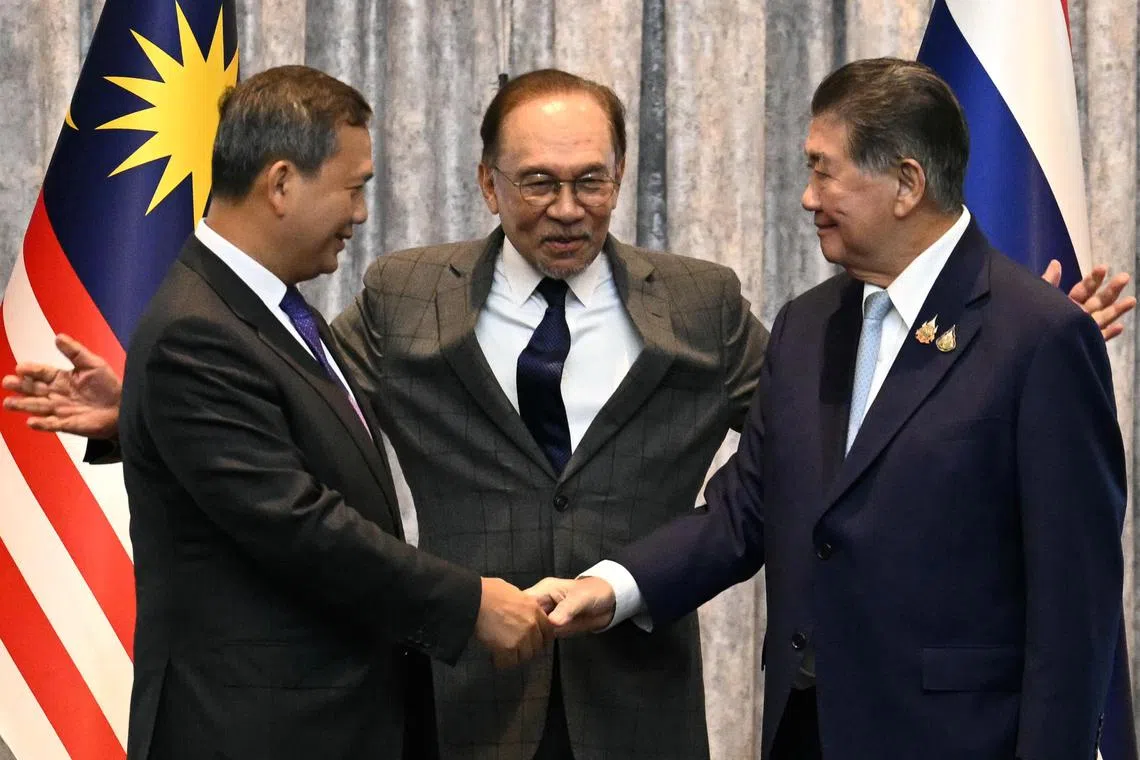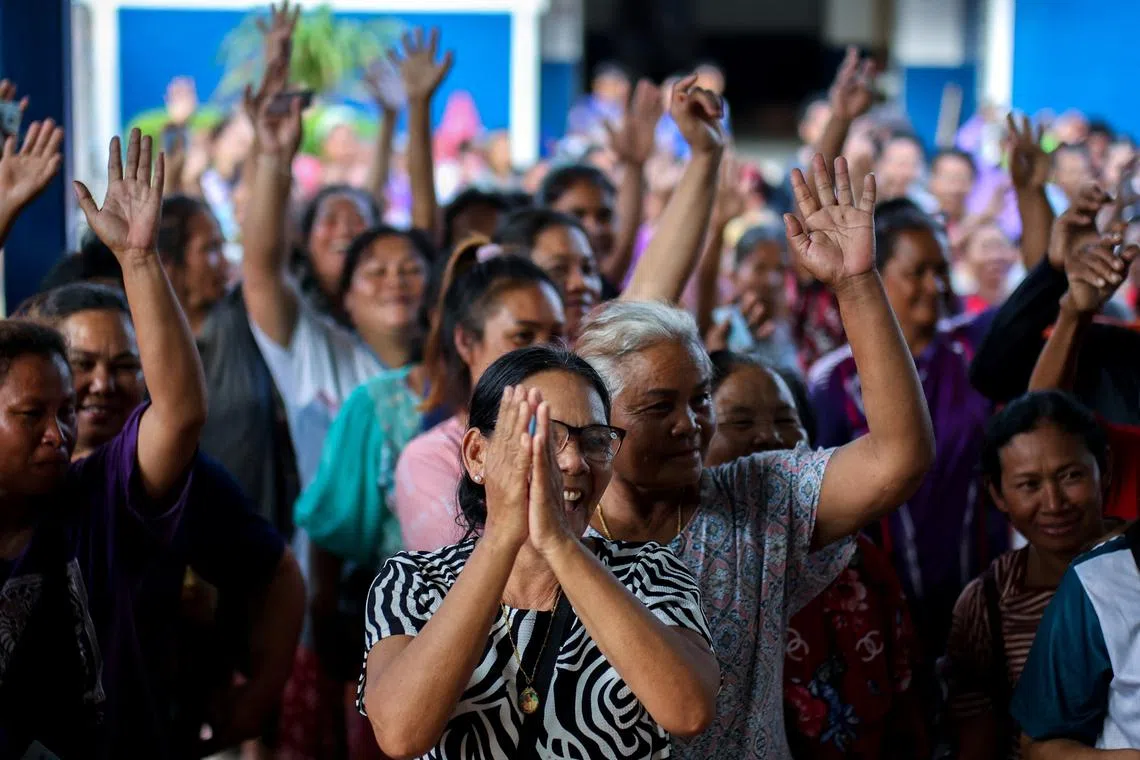News analysis
Truce between Cambodia and Thailand secured under Asean chair Malaysia, but can it hold?
Deal reflects Asean’s reliance on external pressure and proactive chairmanship rather than robust institutional mechanisms, say observers.
Sign up now: Get insights on the biggest stories in Malaysia

(From left) Cambodian Prime Minister Hun Manet, Malaysian Prime Minister Anwar Ibrahim and Thai acting Prime Minister Phumtham Wechayachai after a special meeting in Kuala Lumpur on July 28.
PHOTO: EPA
Follow topic:
- Asean, led by Malaysia, brokered a ceasefire between Thailand and Cambodia after deadly border clashes, marking a diplomatic win for the organisation.
- The agreement, backed by the US and China, involves an immediate ceasefire, military commander meetings, and potential Asean observers, but faces implementation challenges.
- Experts caution about lasting peace due to distrust, lack of Asean enforcement tools, and the need for long-term solutions to border disputes.
AI generated
SINGAPORE – Asean notched a diplomatic win on July 28, with chair Malaysia securing a ceasefire agreement between Cambodia and Thailand after deadly border clashes left more than 30 dead and raised fears of further escalation.
The breakthrough, announced after a special meeting in Kuala Lumpur
But observers say that whether this will translate into lasting peace remains far from certain.
The conflict had simmered since May, with deadly clashes erupting since July 24
The talks were hastened after US President Donald Trump warned on July 27
China also played an active role. Beijing on July 24 expressed concern over the fighting
Both the US and China were present at the July 28 meeting, which Malaysia said was co-organised by Washington, with Beijing’s active participation.
Analysts say the agreement reflects a successful case of Asean-led diplomacy, but also highlights the grouping’s reliance on external pressure and proactive chairmanship rather than robust institutional mechanisms.
Dr Mustafa Izzuddin, a senior international affairs analyst at business consultancy Solaris Strategies Singapore, said that the ceasefire can be billed an Asean success. “Malaysia’s leadership was crucial as the organisation’s chair to mediate between Thailand and Cambodia, while also leveraging the importance of China and the US, both dialogue partners of Asean, to further reaffirm that this ceasefire can be brought into fruition,” he said.
Under the agreement, both sides committed to an immediate and unconditional ceasefire. The peace road map also includes informal meetings between military commanders, and a general border committee session scheduled for Aug 4.
Malaysia, in its capacity as Asean chair, offered to coordinate an observer team and consult fellow member states about participating, a move aimed at providing regional support for verification.
But experts caution that implementation may prove difficult, given the grouping’s lack of enforcement tools.
“A ceasefire is an immediate and very short-term solution. What is more important is for the ceasefire to hold in the long run while Cambodia and Thailand negotiate their border disputes,” said Dr Abdul Rahman Yaacob, a research fellow at the Lowy Institute think-tank. “One possible mechanism is the deployment of Malaysian or Asean observers along the Thai-Cambodia border. This is critical, given the strategic mistrust between (the two sides).”
Observers note that Asean lacks a standing peacekeeping force or formal verification tools. Previous attempts to introduce monitoring mechanisms, such as Indonesia’s proposal to send observers during the 2011 Preah Vihear clashes, were rejected, primarily over sovereignty concerns.
The roots of the current conflict remain murky, but some believe both sides saw political advantage in letting it escalate. While historical grievances over border demarcation persist, the recent clashes appear to have been fuelled in part by domestic political calculations.

Displaced people by the Cambodian-Thai conflict cheering over the announcement of an immediate and unconditional ceasefire on July 28.
PHOTO: REUTERS
That earlier conflict between Cambodia and Thailand also ended in a ceasefire, but tensions persisted for years.
“The biggest risks lie in lingering distrust and potential miscommunication along contested border areas, and the absence of any formal verification mechanism,” said Ms Joanne Lin, a senior fellow at the ISEAS – Yusof Ishak Institute. “Asean does not have institutional tools like independent observers or peace monitors to oversee implementation on the ground.”
These limitations raise broader questions about how Asean handles internal conflict. Some experts warn that without follow-up action, the grouping may revert to inaction once the immediate crisis fades.
“The outcome was driven largely by Malaysia’s personal diplomacy and strong external pressure, rather than any institutional mechanism within Asean,” said Ms Lin, referring to the ceasefire. “Without efforts to institutionalise these crisis response lessons, the group risks falling back into passivity.”
Dr Rahman agreed, saying that it has the capacity to maintain peace – if there is political will.
But he added that an Asean-led ceasefire is more acceptable than one imposed by external powers, and said the grouping has provided its two conflicting members
Others also framed the breakthrough as a significant win for Malaysia’s diplomacy.
Mr Adib Zalkapli, managing director of geopolitical consultancy Viewfinder Global Affairs, said that it showed how Malaysia can step up and play an important role in maintaining peace in the region.
Domestically, the deal may also offer a brief political boost to Datuk Seri Anwar.
“Anwar of course scores some brownie points in brokering this peace that could potentially offset some of his domestic political troubles,” said Dr Oh Ei Sun, a senior fellow at think-tank Singapore Institute of International Affairs.
Still, observers agree the coming weeks will determine whether the ceasefire holds and whether Asean can rise to the challenge of sustaining peace.
“While holding the talks can be seen as a success, there will not be easy solutions to this longstanding issue,” said Dr Bridget Welsh, an honorary research associate at the University of Nottingham Asia Research Institute Malaysia.
For a group long criticised for its inaction on crises like the ones in Myanmar and the South China Sea, the truce offers a chance to prove its relevance and if it can maintain the momentum.
“The real test now lies in verifying the ceasefire and whether Asean can follow through with implementing its own peace mechanisms,” said Ms Lin.
The ceasefire, as much of a win as it is, is a fragile one because ground realities suggest that it could readily break down, said Dr Mustafa.
“So it is incumbent on the political leaderships of both Cambodia and Thailand to maintain the ceasefire by not succumbing to domestic political pressures, and on Malaysia as the honest broker to remind both countries about their bilateral obligations in keeping the peace,” he said.
Additional reporting by Azril Annuar


